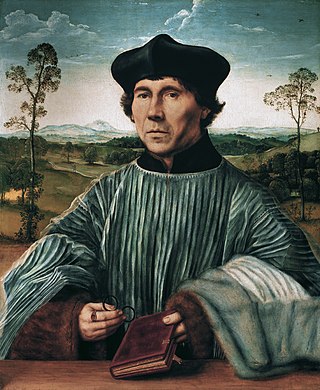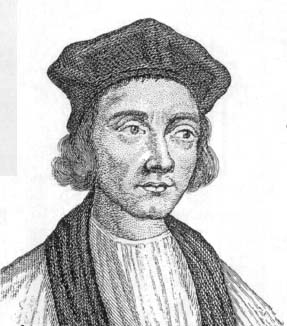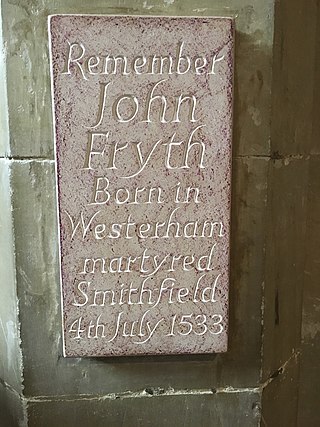
Thomas Wolsey was an English statesman and Catholic cardinal. When Henry VIII became King of England in 1509, Wolsey became the king's almoner. Wolsey's affairs prospered and by 1514 he had become the controlling figure in virtually all matters of state. He also held important ecclesiastical appointments. These included the Archbishop of York—the second most important role in the English church—and that of papal legate. His appointment as a cardinal by Pope Leo X in 1515 gave him precedence over all other English clergy.

Thomas Cromwell, briefly Earl of Essex, was an English statesman and lawyer who served as chief minister to King Henry VIII from 1534 to 1540, when he was beheaded on orders of the king, who later blamed false charges for the execution.

Hugh Latimer was a Fellow of Clare College, Cambridge, and Bishop of Worcester during the Reformation, and later Church of England chaplain to King Edward VI. In 1555 under the Catholic Queen Mary I he was burned at the stake, becoming one of the three Oxford Martyrs of Anglicanism.

Stephen Gardiner was an English Catholic bishop and politician during the English Reformation period who served as Lord Chancellor during the reign of Queen Mary I and King Philip.
John Lambert was an English Protestant martyr burnt to death on 22 November 1538 at Smithfield, London.
Edward Foxe was an English churchman, Bishop of Hereford. He played a major role in Henry VIII's divorce from Catherine of Aragon, and he assisted in drafting the Ten Articles of 1536.

Richard Foxe was an English churchman, the founder of Corpus Christi College, Oxford. He was successively Bishop of Exeter, Bath and Wells, Durham, and Winchester, and became also Lord Privy Seal.

Cuthbert Tunstall was an English humanist, bishop, diplomat, administrator and royal adviser. He served as Bishop of Durham during the reigns of Henry VIII, Edward VI, Mary I and Elizabeth I.
John Bell was a Bishop of Worcester (1539–1543), who served during the reign of Henry VIII of England.

John Frith was an English Protestant priest, writer, and martyr.

Elizabeth Barton, known as "The Nun of Kent", "The Holy Maid of London", "The Holy Maid of Kent" and later "The Mad Maid of Kent", was an English Catholic nun. She was executed as a result of her prophecies against the marriage of King Henry VIII of England to Anne Boleyn.
Bishop Rowland Lee was an English clergyman who served as Bishop of Coventry and Lichfield 1534–43 and also as Lord President of the Marches under King Henry VIII.
Events from the 1530s in England.
John Alen was an English priest and canon lawyer, whose later years were spent in Ireland. He held office as Archbishop of Dublin and Lord Chancellor of Ireland, and was a member of the Privy Council of Ireland. In the latter office, for a few years, he played a central role in the government of Ireland.
John Islip (1464–1532) was abbot of the monastery of Westminster, London, in Tudor times.
John Cottisford was an English churchman and academic, Rector of Lincoln College, Oxford, from 1518.
William Warham was a late-medieval English ecclesiastical administrator who was Archdeacon of Canterbury from c. 1505 to 1532 during the archiepiscopate of his uncle William Warham, Archbishop of Canterbury.
Dr Richard Gwent was a senior ecclesiastical jurist, pluralist cleric and administrator through the period of the Dissolution of the Monasteries under Henry VIII. Of south Welsh origins, as a Doctor of both laws in the University of Oxford he rose swiftly to become Dean of the Arches and Archdeacon of London and of Brecon, and later of Huntingdon. He became an important figure in the operations of Thomas Cromwell, was a witness to Thomas Cranmer's private protestation on becoming Archbishop of Canterbury, and was Cranmer's Commissary and legal draftsman. He was an advocate on behalf of Katherine of Aragon in the proceedings against her, and helped to deliver the decree of annulment against Anne of Cleves.
Ralph Morice was the secretary and biographer of Thomas Cranmer, Archbishop of Canterbury.
John London, DCL was Warden of New College, Oxford, and a prominent figure in the Dissolution of the Monasteries during the reign of Henry VIII of England.









